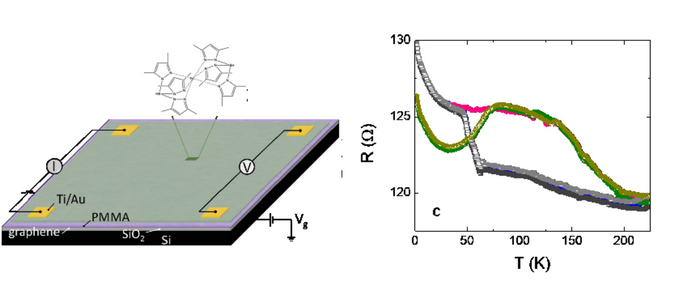Do you want to keep up to date? Subscribe to our newsletter. 1 mail every 2 months! |
 |

Cerdanyola del Vallès, 19 October 2022. The search for more efficient data transport and storage methodologies has helped the development of new research areas, such as molecular spintronics. This novel discipline uses molecular compounds as functional materials in a new generation of devices in which the information tool used is not only the charge (electrons) transport but also the spin. The spin is an intrinsic property of electrons (as mass or electric charge). By adding this new variable of information transport, it is possible to create more efficient electronic devices with a larger capacity for data processing.
There is an increasing demand for discovering new compounds that are functional for spintronics and allow for industrial scalability in its processing. Sublimable spin-crossover (SCO) molecules are compounds of great interest in this matter. These materials can switch between two states called low-spin and high-spin, depending on a variety of external stimuli such as light or temperature. More specifically, compounds based on iron (II) present opposite magnetic properties between both states; paramagnetic in high-spin and diamagnetic in low-spin.
In a novel study published in the journal Advanced Materials, researchers from the Molecular Science Institut (ICMol) from the University of Valencia (UV) in Spain, in collaboration with members from the BOREAS beamline at the ALBA Synchrotron, have developed spin-crossover/graphene hybrid devices by incorporating films of an iron (II) based material, with the properties aforementioned, in its metastable crystallographic phase. Previously thought to be inert regarding spin-crossover, the work developed at the BOREAS beamline has allowed the discovery of interesting thermal and light-induced spin transition capabilities that this crystallographic phase does show when appropriately isolated.
In order to characterize the spin transition of the pure phases directly grown and, by so, distinguish the suitability of each one for its subsequent integrations into a device, it has been necessary to analyze the temperature-dependent variation for the electronic configuration of the central iron (II) atom in the compound molecules. Therefore, X-ray absorption spectroscopy (XAS) measurements at the iron L2 and L3 edges region were performed at the BOREAS beamline for thin films of each one of these phases. First of all, this study revealed the presence of an amorphous component in the metastable phase thin films that recrystallizes in the same phase after several slow thermal cycles an up to a very low temperature. Secondly, this phase presents a high sensitivity to light irradiation, making practically impossible to observe the thermally induced spin transition and producing an exotic phenomenon such as the reverse soft-X-ray-induced excited spin state trapping (reverse-SOXIESST effect) observed for the first time at temperature values around 100 K.
Once the researchers had a glimpse of the possibilities of this material, they used it to fabricate a device that demonstrated outstanding properties as a light-induced spin switch.
All the fabricated devices for this research were measured during tenths of thermal cycles and even after months of staying inside an inert atmosphere, maintaining their properties without almost no variation. Thus, this work has supposed a ground-breaking study about the use of contactless devices, leading to a tool with promising potential for the generation of new systems with applications in spintronics and straintronics (changes in the electrical properties of a material induced by mechanical strains), due to its mechanism of action and its robustness.
Prof. Eugenio Coronado and Dr. Rosa Córdoba, from ICMol, have led this work, which is part of Miguel Gavara Edo’s doctoral thesis.

Figure 1. (Left) Scheme of the fabricated contactless SCO/graphene device. (Right) Temperature-dependent electrical measurements showing cycles without light irradiation (black, grey and blue lines: cooling process and pink line: heating process) and after light irradiation (two green lines: heating process by irradiating at 2 K with a laser for 5 minutes). Cooling cycles reveal an abrupt thermally induced spin transition at 60 K. Heating cycles without irradiation are indicative of a more progressive reversibility in the transition finishing at 180 K. Cycles after light irradiation at 2 K reveal how a thermally induced transition at low temperature is achieved with an efficiency of almost 100%. This efficiency relaxes upon heating over 80 K.
![BOREAS spin-IM3 XAS spectra characterization of [Fe(Pyrz)2] films in each of its phases. a) and d) Spectra and spin transition behavior for the stable phase (triclinic). b) and e) Spectra and spin transition behavior for the metastable phase (tetragonal). c) and f) Spectra and spin transition behavior for the metastable after several thermal cycles (first spectra taken for each temperature value). G) and h) Spectra and spin transition behavior for the metastable phase after several thermal cycles (third spectra taken for each temperature value). i) comparative between spin transition behavior characterize between the first and the third spectra taken for each temperature value for the metastable phase after several thermal cycles, thus showing its exotic susceptibility to X-ray irradiation.](https://www.albasynchrotron.es/en/media/news/BOREASspinIM3.png/@@images/1b5e3127-5d80-4d5c-b150-7fdab7db016a.png)
Figure 2. XAS spectra characterization of [Fe(Pyrz)2] films in each of its phases. a) and d) Spectra and spin transition behavior for the stable phase (triclinic). b) and e) Spectra and spin transition behavior for the metastable phase (tetragonal). c) and f) Spectra and spin transition behavior for the metastable after several thermal cycles (first spectra taken for each temperature value). G) and h) Spectra and spin transition behavior for the metastable phase after several thermal cycles (third spectra taken for each temperature value). i) comparative between spin transition behavior characterize between the first and the third spectra taken for each temperature value for the metastable phase after several thermal cycles, thus showing its exotic susceptibility to X-ray irradiation.
Reference: Miguel Gavara-Edo, Rosa Córdoba, Francisco Javier Valverde-Muñoz, Javier Herrero-Martín, José Antonio Real, Eugenio Coronado. Electrical Sensing of the Thermal and Light-Induced Spin Transition in Robust Contactless Spin-Crossover/Graphene Hybrid Devices. Advanced Materials (2022). DOI: https://doi.org/10.1002/adma.202202551
With the collaboration of Fundación Española para la Ciencia y la Tecnología. The ALBA Synchrotron is part of the of the Unidades de Cultura Científica y de la Innovación (UCC+i) of the FECYT and has received support through the FCT-21-17088 project.





